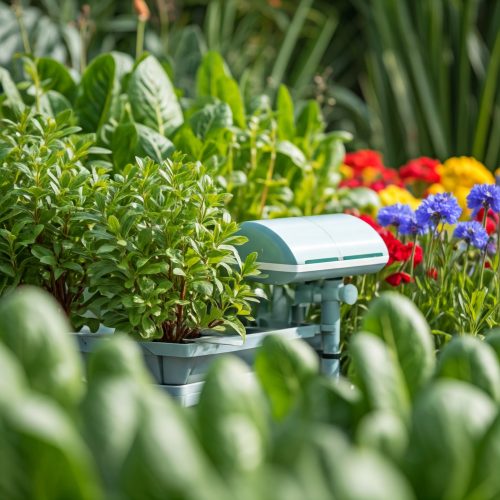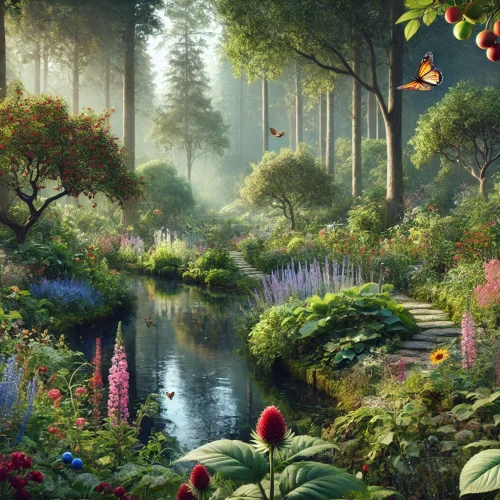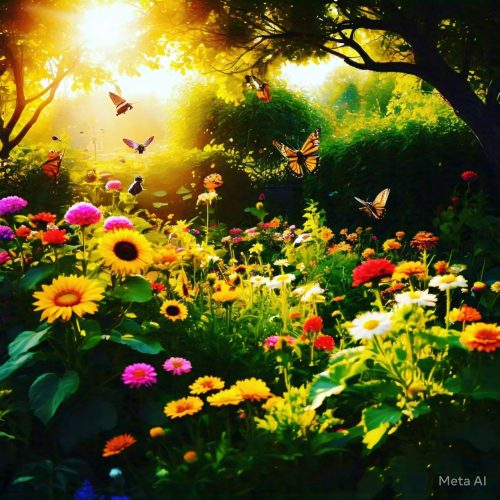Welcome to our guide on fertilizers for gardens. Fertilizers are key for garden care, giving plants the nutrients they need. The right fertilizer can keep your soil healthy and your plants vibrant. We’ll help you find the best fertilizer for your garden in this article.
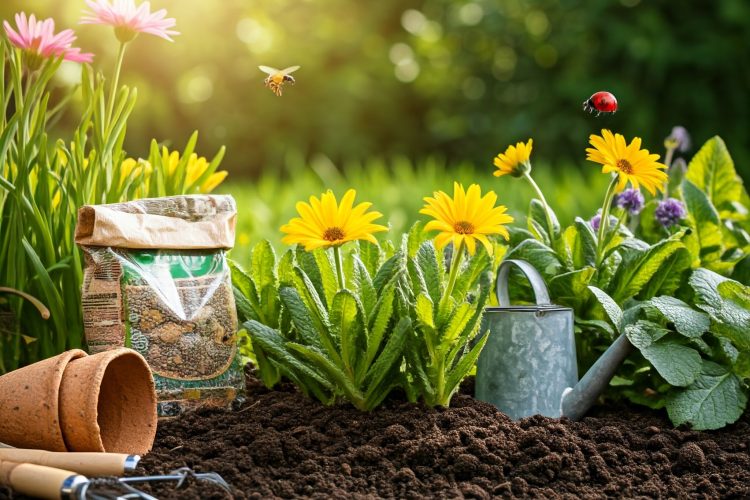
Fertilizers are essential for a thriving garden. They provide the nutrients plants need to grow well. This guide is for both new and experienced gardeners. It will help you choose the right fertilizer for your garden.
Key Takeaways
- Choose the right fertilizer for your garden to promote healthy plant growth
- Understand the importance of fertilizer in garden care and soil health
- Learn about different types of fertilizers and their benefits
- Discover how to apply fertilizer for optimal results
- Find out how to avoid common mistakes when using fertilizer
- Explore natural and homemade fertilizer options for your garden
Understanding Garden Fertilizer Basics
Fertilizers are key for plant growth. They give plants the nutrients they need to do well. Knowing how to use them can greatly improve your garden’s health. NPK ratios are important for plant development, as they balance nitrogen, phosphorus, and potassium.
Let’s look at the basics of fertilizers. Macro nutrients like nitrogen, phosphorus, and potassium are vital for growth. Micronutrients, such as iron and zinc, are also crucial for plant health. Knowing this helps you pick the right fertilizer for your garden.
What Are NPK Ratios?
NPK ratios show the percentage of nitrogen, phosphorus, and potassium in a fertilizer. For example, a 10-10-10 ratio means 10% of each. This balance is key for your plants’ health and growth.
Macro vs. Micronutrients
Macro nutrients are the main parts of fertilizers. Micronutrients are important for plant health. Here’s a table showing the main differences:
| Nutrient Type | Function |
|---|---|
| Nitrogen (Macro) | Promotes leaf growth and development |
| Phosphorus (Macro) | Supports root growth and flower production |
| Potassium (Macro) | Enhances overall plant health and resistance |
| Iron (Micronutrient) | Essential for chlorophyll production and photosynthesis |
Why Plants Need Fertilizer
Plants need fertilizers to get the nutrients they can’t get from the soil. Knowing about NPK ratios and micronutrients helps you give your plants what they need. This knowledge helps you choose the best fertilizer for your garden.
Types of Garden Fertilizers Available Today
There are many fertilizer types for your garden, each with its own benefits and drawbacks. You can choose between organic fertilizers and synthetic fertilizers. Knowing the differences helps you pick the best one for your garden.
Organic fertilizers like compost, manure, and green sand are natural. They are full of nutrients and make the soil better for plants. Synthetic fertilizers, made from chemicals, give plants a quick nutrient boost.
When deciding between organic fertilizers and synthetic fertilizers, think about the environment. Organic fertilizers are better for the planet because they break down naturally and are safe. But, synthetic fertilizers can harm the soil and water if not used right.
- Organic fertilizers: natural, biodegradable, and non-toxic
- Synthetic fertilizers: manufactured, quick-acting, and potentially environmentally harmful
| Fertilizer Type | Benefits | Drawbacks |
|---|---|---|
| Organic | Environmentally friendly, improves soil structure | Can be slow-acting, may have unpleasant odors |
| Synthetic | Quick-acting, convenient to use | Can contribute to soil pollution, may be toxic to pets and wildlife |
Organic vs. Synthetic Fertilizers: Making the Right Choice
When you’re fertilizing your garden, you have two main choices: organic and synthetic fertilizers. Organic fertilizers, like compost and manure, are made from natural stuff. They help make your soil better and more fertile. Synthetic fertilizers, on the other hand, are chemicals that give plants nutrients fast.
Thinking about how fertilizers affect the environment is key. Organic fertilizers are better for the planet because they’re natural and good for soil. But, synthetic fertilizers can pollute soil and water if not used right.
Benefits of Organic Fertilizers
- Improve soil structure and fertility
- Support healthy microbial activity
- Lower environmental impact
Advantages of Synthetic Fertilizers
- Provide quick nutrient fixes for plants
- Can be more convenient to use
- Often less expensive than organic fertilizers
Environmental Impact Considerations
When picking between organic and synthetic fertilizers, think about the planet. Organic fertilizers are better for the earth because they’re natural and good for soil. Synthetic fertilizers, however, can harm soil and water if not used carefully. Choosing organic fertilizers helps make your garden more eco-friendly.
| Fertilizer Type | Environmental Impact |
|---|---|
| Organic Fertilizers | Lower environmental impact, improves soil health |
| Synthetic Fertilizers | Can contribute to soil pollution and water contamination |
How to Choose the Best Fertilizer for Different Plants
Choosing the right fertilizer is key for garden care. Each plant has its own needs. Using plant-specific fertilizers can greatly improve their health and growth. It’s important to know what your plants need.
Understanding the NPK ratio and micronutrients is crucial. For instance, flowers need more phosphorus, while leafy greens need nitrogen. The right plant-specific fertilizers ensure your plants get the nutrients they need.
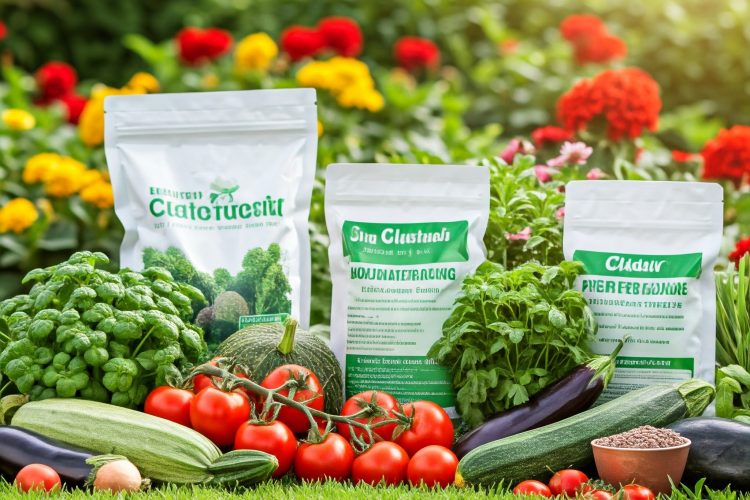
- Read the label carefully to ensure the fertilizer meets your plant’s specific needs
- Consider the soil type and pH level when selecting a fertilizer
- Look for plant-specific fertilizers that are specifically designed for your type of plant
By following these tips, you can choose the best fertilizer for your plants. This way, you provide them with the best garden care.
Seasonal Fertilizer Application Guide
As the seasons change, so do the needs of your garden. A well-planned seasonal fertilization schedule is key to a healthy garden. We’ll look at the best fertilizer application practices for each season.
Adjusting your fertilizer use with the seasons is crucial for garden care. This ensures your plants grow well and stay healthy. Here’s what to do in each season:
Spring Feeding Schedule
In spring, focus on nutrients for new growth. Use a balanced fertilizer with nitrogen, phosphorus, and potassium in equal parts.
Summer Maintenance
In summer, plants need more fertilizer application for ongoing growth. A water-soluble fertilizer is easy to apply.
Fall Preparation
In fall, get your garden ready for winter with a fertilizer that boosts root growth.
Winter Care
In winter, cut back on fertilizer application to once a month. This helps save nutrients and avoid over-fertilizing.
Here’s a quick guide to seasonal fertilizer use:
| Season | Fertilizer Application |
|---|---|
| Spring | Balanced fertilizer (N-P-K) |
| Summer | Water-soluble fertilizer |
| Fall | Fertilizer for root growth |
| Winter | Reduced fertilizer application |
Common Fertilizer Application Methods
Gardeners have many ways to apply fertilizers. The most common are granular, liquid, and slow-release methods. Each has its own advantages and disadvantages. The right choice depends on the plants, soil, and the gardener’s preference.
Choosing the right fertilizer method is crucial for plant health. Granular fertilizers are popular because they’re easy to use and release nutrients slowly. Liquid fertilizers are great for plants that need a quick nutrient boost.
Granular Application Techniques
Granular fertilizers are sprinkled around plants. They’re good for flowers, veggies, and trees. The benefits include:
- Easy to apply
- Slow release of nutrients
- Cost-effective
Liquid Fertilizer Tips
Liquid fertilizers are sprayed on plants. They’re perfect for seedlings and transplants. The advantages are:
- Quick absorption of nutrients
- Ideal for seedlings and transplants
- Easy to mix with water
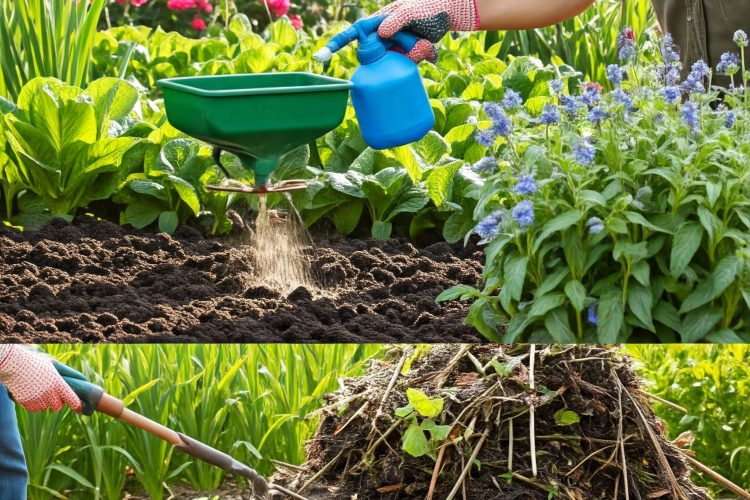
In conclusion, the choice of fertilizer method depends on plant needs and personal preference. Knowing the different methods helps gardeners make the best choice for their plants.
| Fertilizer Type | Benefits | Drawbacks |
|---|---|---|
| Granular Fertilizers | Easy to apply, slow release of nutrients | May not be suitable for all plants |
| Liquid Fertilizers | Quick absorption of nutrients, ideal for seedlings | May be more expensive than granular fertilizers |
Signs Your Garden Needs Fertilizer
To keep your garden healthy, it’s key to spot fertilizer deficiency signs. These signs change based on the plants, soil, and weather. Look for yellow leaves, slow plant growth, and less fruit.
A deficiency can happen for many reasons. It might be because of not enough nutrients, bad soil, or not enough water. To fix this, gardeners can use the right fertilizer. Here are some important signs to watch for:
- Discolored or distorted leaves
- Reduced flower or fruit production
- Slow or stunted plant growth
- Poor root development
By spotting these signs early and acting fast, gardeners can stop fertilizer deficiency. This helps plants grow well, making your garden strong and fruitful. Keeping an eye on your garden’s health and using fertilizer when needed is crucial.
Natural and Homemade Fertilizer Options
For gardeners, natural and homemade fertilizers are great alternatives. They cut down on synthetic products and are better for the planet. Composting, for example, makes soil rich in nutrients, helping plants grow well.
Composting is easy and effective. It mixes kitchen waste and yard trimmings to create a nutrient-rich compost. This method also reduces waste and is good for the environment. Homemade fertilizers, like those from kitchen waste, are another option. They can be made from coffee grounds, eggshells, and vegetable scraps.
Compost-Based Solutions
Compost-based solutions are popular among gardeners. They are easy to use and work well. By mixing compost with green manure or worm castings, you get a fertilizer full of nutrients and microorganisms. This is perfect for growing healthy plants.
Kitchen Waste Fertilizers
Kitchen waste fertilizers help gardeners reduce waste. They can be made from fruit and vegetable peels, tea bags, and coffee grounds. Using kitchen scraps to make fertilizer is a great way to make your garden more sustainable.
Green Manure Techniques
Green manure techniques use living plants to add nutrients to the soil. This method is sustainable and saves money. By adding green manure to your garden, you improve soil fertility and structure. This leads to healthier, more productive plants. With these natural and homemade, gardeners can make their gardening more sustainable and reduce their use of synthetic products.
Avoiding Common Fertilizer Mistakes
Fertilizing your garden right is key. Knowing fertilizer mistakes can harm plants and the environment is crucial. Over-fertilizing is a big mistake. It adds too many nutrients to the soil, which can hurt your plants.
To avoid this, follow the recommended amounts. Also, think about what your plants really need.
Another important thing is fertilizer safety. Storing and handling fertilizers wrong can be dangerous. Keep them in a well-ventilated spot, away from kids and pets. Always follow the instructions on the label.
- Always read and follow the label instructions
- Wear protective clothing and gloves when handling fertilizers
- Keep fertilizers out of reach of children and pets
- Dispose of leftover fertilizers and packaging responsibly
By being careful with these fertilizer mistakes, you can have a healthy garden. You’ll also protect the environment and keep things safe. Stay informed on the best ways to fertilize your garden. This way, you can avoid over-fertilization and other mistakes.
🌱 Subscribe to Our YouTube Channel:
Check out The Green Living Spaces for video guides, tips, and inspiration to help you along your gardening journey.
📖 Popular Articles You May Like:
Explore our curated list of helpful guides at Popular Articles – The Green Living Spaces.



